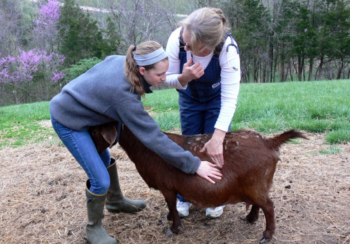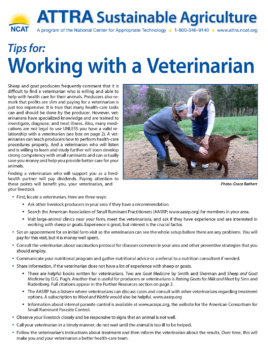Tips for Working with a Veterinarian
By Linda Coffey, NCAT Livestock Specialist

Photo: Grace Rathert
Sheep and goat producers frequently comment that it is difficult to find a veterinarian who is willing and able to help with health care for their animals. Producers also remark that profits are slim and paying for a veterinarian is just too expensive. It is true that many health-care tasks can and should be done by the producer. However, veterinarians have specialized knowledge and are trained to investigate, diagnose, and treat illness. Also, many medications are not legal to use UNLESS you have a valid relationship with a veterinarian (see box below). A veterinarian can teach producers how to perform health-care procedures properly. And a veterinarian who will listen and is willing to learn and study further will soon develop strong competency with small ruminants and can actually save you money and help you provide better care for your animals.
Finding a veterinarian who will support you as a herd-health partner will pay dividends. Paying attention to these points will benefit you, your veterinarian, and your livestock.
- First, locate a veterinarian. Here are three ways:
- Ask other livestock producers in your area if they have a recommendation.
- Search the American Association of Small Ruminant Practitioners (AASRP) for members in your area.
- Visit large-animal clinics near your farm, meet the veterinarians, and ask if they have experience and are interested in working with sheep or goats. Experience is great, but interest is the crucial factor.
- Set an appointment for an initial farm visit so the veterinarian can see the whole setup before there are any problems. You will pay for this visit, but it is money well spent.
- Consult the veterinarian about vaccination protocol for diseases common in your area and other preventive strategies that you should employ.
- Communicate your nutritional program and gather nutritional advice or a referral to a nutrition consultant if needed.
- Share information, if the veterinarian does not have a lot of experience with sheep or goats.
- There are helpful books written for veterinarians. Two are Goat Medicine by Smith and Sherman; and Sheep, Goat, and Cervid Medicine by D.G. Pugh and N. Baird. Another that is useful for producers or veterinarians is Raising Goats for Milk and Meat by Sinn and Rudenberg.
- The AASRP has a listserv where veterinarians can discuss cases and consult with other veterinarians regarding treatment options. A subscription to Wool and Wattle would also be helpful.
- Information about internal parasite control is available at the American Association of Small Ruminant Practitioners website.
- Observe your livestock closely and be responsive to signs that an animal is not well.
- Call your veterinarian in a timely manner; do not wait until the animal is too ill to be helped.
- Follow the veterinarian’s instructions about treatment and then inform the veterinarian about the results. Over time, this will make you and your veterinarian a better health-care team.
- Identify the reasons for animal deaths. Post-mortems can give vital information to help you and your veterinarian improve health practices to prevent further losses.
- Keep careful records about all illnesses and death losses and review them with your veterinarian periodically to look for patterns that may suggest the weak area in the system. For example, if most illnesses are nutrition-related, improving the nutritional program will be an important measure to take.
- If death loss is excessive, ask your veterinarian to visit the farm again and help you troubleshoot the situation.
Valid Veterinarian-Client-Patient Relationship
Instructions from the U.S. Food and Drug Administration (FDA) to veterinarians (addressed as “you”):The AMDUCA provisions of the FD&C Act allow extra-label drug use only on the lawful order of a licensed veterinarian in the context of a valid veterinarian-client-patient relationship. A valid veterinarian-client-patient relationship has three parts:
- You have assumed responsibility for making medical judgments about the health of an animal, or animals, and the need for medical treatment. In turn, the client (the owner or other animal caretaker) has agreed to follow your instructions;
- You have sufficient knowledge of the animal, or animals, to develop a general or preliminary diagnosis of the medical condition; and
- You are readily available for follow-up in case of adverse drug reactions or treatment failure.
Such a relationship can exist only when you have recently seen the animal and are personally acquainted with its care. This means you have recently examined the animal, have made “medically appropriate and timely visits” to where the animal is kept (usually the case for food-producing animals), or done both.
Working effectively with your veterinarian will benefit your business in the long run. Consulting with a veterinarian to set up a good preventive-care program is cost-effective.
Further Resources
Goat Medicine. 1994. By Mary C. Smith and David M. Sherman. Lippincott Williams & Wilkins, a Wolters Kluwer Company, Baltimore, MD.
This book is very technical, but it includes a chapter on herd health management and preventive medicine. This is an authoritative and very helpful book for veterinarians.
Sheep and Goat Medicine. 2002. Edited by D. G. Pugh. W.B. Saunders Company, an Imprint of Elsevier Science, Pennsylvania, PA.
This book is designed to provide a text on sheep and goat medicine, nutrition, surgery, and reproduction in an easily usable form; language is more accessible, and there are lots of helpful charts, tables, illustrations, and photos. It includes chapters on handling and examination of sheep and goats, feeding and nutrition (with practical examples), and flock health.
Raising Goats for Milk and Meat, Revised Edition, 2008. By Rosalee Sinn and Paul Rudenberg. Heifer International, Little Rock, AR.
Primarily written for trainers working with groups of farmers, especially in developing countries, this book is useful for individual producers as well. Chapter 8, Health Care for Your Goats, is highly useful, practical, and readable. There is a table listing health problems, common causes and characteristics, other signs, prevention, and treatment.
Goat Health Handbook. 1983. By Thomas R. Thedford, DVM. Winrock International, Morrilton, AR
Subtitled “A Field Guide for Producers with Limited Veterinary Services,” this book and a companion title for sheep will be highly useful in teaching producers how to observe and examine their animals and notice relevant aspects of behavior and physical state. Both diagnostic guides and more-detailed disease descriptions are provided, including symptoms, information about disease cause and transmission, prevention and treatment, and human health concerns. Find used copies online.
Tips for: Working with a Veterinarian
By Linda Coffey, NCAT Livestock Specialist
Published April 2015
©NCAT
IP496
Slot 509
This publication is produced by the National Center for Appropriate Technology through the ATTRA Sustainable Agriculture program, under a cooperative agreement with USDA Rural Development. This publication was also made possible in part by funding from the USDA, NIFA Organic Research and Education Initiative, project 2010-51300-21641. ATTRA.NCAT.ORG.


